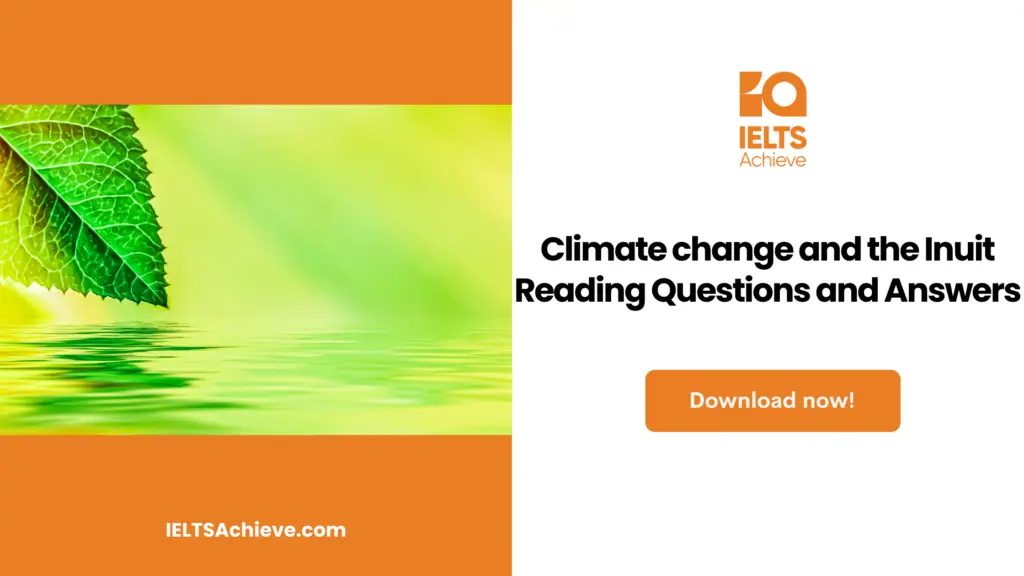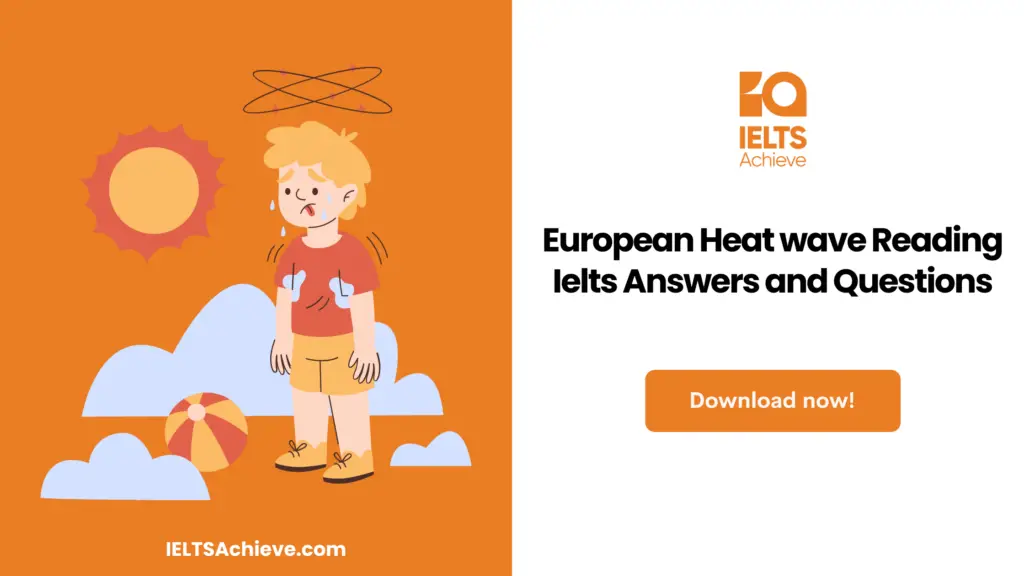The Blog post contains the following IELTS Reading Questions:
- IELTS Reading Locating Information
- IELTS Reading Table Completion
- IELTS Reading Matching Features
Stay informed and prepared for success – Explore our comprehensive Reading Test Info page to get valuable insights, exam format details, and expert tips for mastering the IELTS Reading section.
IELTS reading passage – Reducing effects of climate change

Reducing Effects of Climate Change
Many scientists now think that considerable global warming is already unavoidable because of our reliance on fossil fuels and the amount of carbon dioxide already emitted into the atmosphere. They argue that the most we can do are maintain it at a tolerable level and that reducing carbon emissions is now the only viable option for doing so. However, although some nations have made significant progress, most are struggling just to slow the rate of rise, much alone turn it around. Geo-engineering, which typically refers to the deliberate large-scale alteration of the environment, is thus being investigated by an increasing number of scientists as a potential solution. Geo-engineering, in the opinion of its supporters, is comparable to a backup generator. If Plan A, decreasing our reliance on fossil fuels, doesn’t work, proponents of geo-engineering argue, we’ll need to resort to huge ideas to either halt or reverse global warming.
At least on a localized basis, geo-engineering has been proven to be effective. Dry ice, silver iodide, and cement powder have been dropped from airplanes to keep the skies over Moscow’s MayDay parades pristine for decades. Several current proposals, on the other hand, aim to limit solar energy’s impact on Earth. A concept proposed by University of Arizona professor Roger Angel stands out among the rest as the most intriguing. According to his plan, a sunshade capable of diffusing sunlight would be constructed 1.5 million kilometers above Earth using as many as 16 trillion tiny spacecraft, each weighing around one gram. Angel claims this might cut the amount of sunlight reaching Earth by 2%.
The majority of geoengineering activities that have been conducted up to this time have focused on the objective of causing a global cooling of the earth. These initiatives include planting trees in arid regions and adding iron to the ocean to encourage the growth of algae. Many people, particularly in the Arctic, are, nevertheless, specifically interested in stopping the ice from melting at the poles. It has been suggested that reducing the amount of warming that happens in the atmosphere and seas may be accomplished by increasing the quantity of light that is reflected back into space by growing ice sheets and frozen water at high latitudes.
Several researchers in the scientific community have put up the idea that aerosol sprays should be released into the stratosphere located above the Arctic. For this to work, sulfur or hydrogen sulfide aerosols would have to be used. This would result in the formation of sulfur dioxide clouds, which would then lead to a reduction in overall brightness. The concept is based on historical volcanic eruptions, such as the one that occurred at Mount Pinatubo in the Philippines in 1991. This eruption caused a temporary drop of 0.5 degrees Celsius in the average temperature of the whole planet.
In order to avoid glaciers from dislodging into the ocean, researchers have also investigated if it is feasible to protect the Greenland ice sheets with strengthened high-tension cables. Meanwhile, proposals for geoengineering in the Russian Arctic involve the cultivation of hundreds of birch trees. Since birches lose their leaves in wintertime, radiation can be scattered by the snow instead of being absorbed by it like it is by the natural evergreen pines of the area. According to some climate experts, rerouting Russian rivers to boost the flow of cold water to locations that generate ice might potentially be utilized to reduce warming.
If so, when? Geoengineering is viewed skeptically by researchers. Angel believes renewable energy is the only long-term solution, and his technology isn’t a substitute. Dr. Phil Rasch of the Pacific Northwest National Laboratory agrees: “we would all likely agree that the world would return to its pre-engineered state within ten to twenty years if we were to stop geoengineering on a certain day. There is definitely cause for concern about it.” This worries me. The US National Center for Atmospheric Research has previously warned that the idea to inject sulfur into the atmosphere might impact rainfall patterns in the tropics and the Southern Ocean. Rasch states that geoengineering proposals to inject stratospheric aerosols or seed clouds would serve to chill the earth and enhance the area of sea ice. However, all models imply that precipitation distribution is affected in some way.
The possibility of “overshooting Y” is another danger associated with geoengineering initiatives, according to Dr. Dan Hunt of the University of Bristol’s School of Geophysical Sciences, who has researched the potential effects of the sunshade and aerosols programs on the weather. The danger is that the polar will still be warmer than they should be and the tropics will be colder than they were before industrialization, even if you manage to return global temperatures to pre-industrial levels. According to Hunt, “Angel’s project would have to run at half strength to prevent such a situation; all of this supports his belief that the wisest course of action is to eliminate the necessity for geo-engineering entirely.
Many scientists advocate geoengineering because they don’t have much trust in the government’s capacity to come to an agreement on the necessary carbon reductions and then implement them. Even well-known conservation groups recognize the importance of looking into geoengineering’s possibilities. “Human-induced climate change has led mankind to a situation where we shouldn’t exclude thinking carefully about this issue and its prospects,” says Dr. Martin Sommerkorn. He is the advisor for the World Wildlife Fund’s International Arctic Programme regarding climate change.
Questions 1-3
Reading Passage has eight paragraphs A-HWhich paragraph contains the following information? Write the correct letter, A-H, in boxes 1-3 on your answer sheet.
1. _____a reference to a geoengineering venture based on previous natural phenomena.
2. _____a case in point of the advantageous application of geoengineering.
3. _____a typical explanation of what geoengineering is.
Questions 4-10
Complete the table below. Choose ONE WORD ONLY from the passage for each answer. Write your answers in boxes 4-10 on your answer sheet.
GEO-ENGINEERING PROJECTS
| Procedure | Aim |
| place a lot of little spacecraft in orbit far above the Earth. | t o create a 4 _____ that would lessen the amount of light that would hit The earth. |
| Place 5 _____ in the sea | to encourage 6 _____ to form |
| sending aerosols into space | to create 7 _____that would reduce the amount of light reaching Earth |
| fix strong 8 _____to Greenland ice sheets | in order to stop icebergs from sliding into the ocean |
| Plant trees that would shed their leaves in the winter in the Russian Arctic. | to allow the 9 _____ to reflect radiation |
| change the direction of 10. _____ | to supplement regions that already contain ice by adding cold water |
Boost your performance in Summary, Notes, Table, and Flowchart Completion tasks. Click here to explore our detailed guide and learn how to effectively complete summaries, notes, tables, and flowcharts in the IELTS Reading section.
Questions 11-14
Look at the following statements and the list of scientists below. Match each statement with the correct scientist, A-D. Write the correct letter, A-D, in boxes 11-14 on your answer sheet.
List of Scientists
- Roger Angel
- Phil Rasch
- Dan Hunt
- Martin Sommerkorn
11. _______The efficacy of geoengineering programs may need to be restricted.
12. _______Geoengineering is a field that warrants further investigation.
13. _______Geoengineering may not have long-lasting impacts.
14. _______Geoengineering cannot take the role of research into non-fossil fuels.
Improve your performance in Matching Features questions by clicking here to access our comprehensive guide. Learn how to match specific features or characteristics with the options provided in the IELTS Reading section.
Unlock your full potential in the IELTS Reading section – Visit our IELTS Reading Practice Question Answer page now!
Recommended Questions:
Renewable Energy IELTS Reading Question with Answer
Reducing effects of climate change Answers
1. D
2. B
3. A
4. Sunshade
5. Iron
6. Algae
7. Clouds
8. Cables
9.Snow
10. Rivers
11. B
12. D
13. C
14. A

We hope you found this post useful in helping you to study for the IELTS Test. If you have any questions please let us know in the comments below or on the Facebook page.
The best way to keep up to date with posts like this is to like us on Facebook, then follow us on Instagram and Pinterest. If you need help preparing for the IELTS Test, join the IELTS Achieve Academy and see how we can assist you to achieve your desired band score. We offer an essay correction service, mock exams and online courses.


